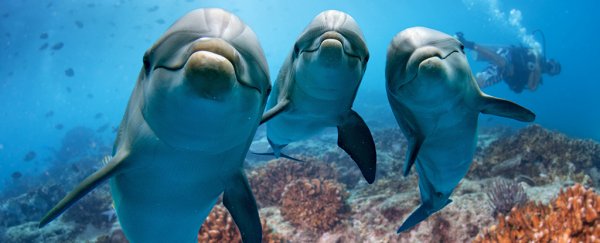New research says whales and dolphins (cetaceans) have social lives much like ours, with tight-knit social groups, complex relationships, regional dialects, and one-to-one chats. And it's all thanks their beautiful brains.
Information on 90 different species of dolphins, whales, and porpoises was collected by the international team of scientists, making this the first study of its kind to gather such a large dataset on cetacean brain size and social behaviour.
The study links these advanced social behaviours with the size and the expansion of the cetacean brain, technically known as encephalisation, or the relationship between an animal's brain size and its total mass.
"As humans, our ability to socially interact and cultivate relationships has allowed us to colonise almost every ecosystem and environment on the planet," says one of the team, Susanne Shultz from the University of Manchester in the UK.
"We know whales and dolphins also have exceptionally large and anatomically sophisticated brains and, therefore, have created a similar marine-based culture."
The researchers found a long list of behavioural similarities shared with humans, including working together for mutual benefit, teaching each other how to hunt and how to use tools, and cooperative hunting.
Cetaceans were also found to use complex vocalisations, including regional group dialects, and have unique signature whistles that act as names.
Other observed social behaviours include social play, cooperation with humans and other species, and alloparenting – looking after youngsters that aren't your own.
Those animals in smaller groups or on their own were found to have the smallest brains, backing up the idea that cetaceans, like humans, do much of their learning socially and become smarter in groups.
The findings fit in with the social brain hypothesis (SBH) and cultural brain hypothesis (CBH) say the scientists, the idea that large brains evolve as animals are exposed to complex and information-rich social environments.
However, dolphins and whales didn't necessarily get all of the evolutionary breaks that humans did, so won't be moving into the neighbourhood anytime soon.
"Unfortunately, they won't ever mimic our great metropolises and technologies because they didn't evolve opposable thumbs," says Shultz.
And biologist Luke Rendell from the University of St Andrews in the UK, who wasn't involved in the study, warns against going too far in anthropomorphising these marine creatures.
"There is a risk of sounding like there is a single train line, with humans at the final station and other animals on their way of getting there," Rendell told Katharina Kropshofer at The Guardian. "The truth is that every animal responds to their own evolutionary pressures."
While we might share certain social activities with dolphins and whales, our brains aren't structured in the same way, which raises the question of how different species with very different brains can end up hunting and chatting in similar ways.
The team says the research can therefore teach us more about humans and our own evolution as well as the social behaviours of our marine animal friends – they can act as a "control group" to compare with human beings.
"This research isn't just about looking at the intelligence of whales and dolphins, it also has important anthropological ramifications as well," says one of the researchers, Michael Muthukrishna from the London School of Economics in the UK.
"In order to move toward a more general theory of human behaviour, we need to understand what makes humans so different from other animals."
The research has been published in Nature Ecology & Evolution.
